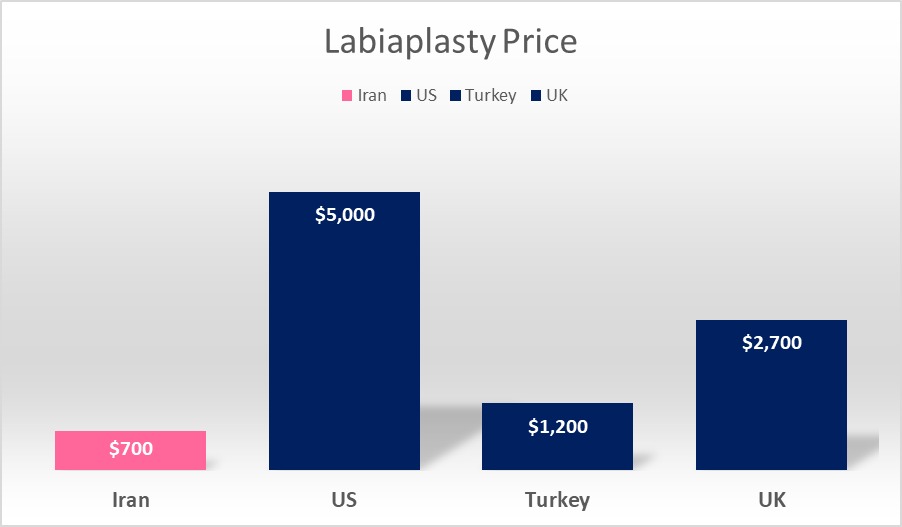What is Labiaplasty?
How much does labiaplasty cost in Iran?
Cost of Labiaplasty at Tehran city in 2022 starts from 1000 USD. However if you want a cheaper price with the same quality you can choose Shiraz city where Labiaplasty cost starts from 700 USD.

Labiaplasty is a surgical procedure that can improve both cosmetic and health concerns in your vaginal area by reshaping or resizing the vaginal lips or labia. Labiaplasty can help address the size, shape or symmetry of your labia.
Read more about : Virgin tightening surgery before and after pictures
Read more about : The German patient saved $ 14,000 by choosing Iran over Germany to have stomach liposuction and abdominoplasty surgery.
Read more about : The Swedish patient saved $ 90,000 by choosing Iran over the United States to have leg lengthening surgery.
Before Labiaplasty
Reasons for a labiaplasty
There are a host of reasons females have enlarged labia, including childbirth, aging, s-e-x-u-a-l activity and genetics. Females choose to have surgery for several reasons. First, there are several functional benefits when electing for a labiaplasty. Many females who suffer from an enlarged labia experience difficulty with exercise, hygiene, urinary tract infections, s-e-x-u-a-l activity and other physical activity.
Furthermore, with the increasing trend of wearing yoga pants, workout pants and swimming suits, an enlarged labium can make it difficult to wear such clothes. However, most female patients describe feeling extremely self-conscious when becoming romantically involved with their partners. These reasons and others are what females consider when choosing a labiaplasty.
Is labiaplasty right for you?
Even if you are in excellent physical health and do not smoke, not every woman will be a good candidate for labiaplasty. As with any surgical procedure, being in good health is essential, as is not smoking as this can interfere with recovery. But what makes a good candidate for labiaplasty? If the size or shape of your labia affects your self-confidence or interferes in your daily activities, you may be an ideal candidate for labiaplasty.
Read more about : mini facelift recovery pictures day by day
Read more about : mtf bottom surgery result pictures
Read more about : How to pop a bartholin cyst yourself?
Read more about : How long after breast reduction will i know my size?
What should you expect at your initial consultation?
In your pre-surgery consultation, your doctor will provide guidelines establishing the best possible result. Analysis of your medical record will provoke any further action taken including; blood tests, urine samples and X-rays.
During an initial consultation, your plastic surgeon will help determine if labiaplasty is the right option for you. You need to let the surgeon know how your current labia structure impacts your daily life and what you expect from surgery. This is the time to ask any questions you may have about your surgery.
How should you prepare for labiaplasty?
Once you decide that labiaplasty is right for you, you need to begin planning for your procedure and recovery. You should plan on taking at least a week off from work. In the time leading up to the procedure, make sure you are eating healthy, drinking water and getting plenty of sleep. Establishing healthy habits before your surgery can help support a quicker recovery.
The first few days after the procedure should be devoted to rest, so talk with family and friends about helping around the house, especially if you have young children. Stock up on groceries, prescriptions and any items you may need during recovery before the procedure.
Potential Risks
When you have any type of surgery, there are of course potential risks. The degree of risk changes depending on the type of procedure, and labiaplasty is very low risk. However, there are risks nonetheless:
. Excessive bleeding
. Infection
. Scarring
. Loss of sensation
Although these risks are very rare, it is imperative to discuss any worries or concerns that you have about them before going into the surgery.
Read more about : Breast implant in Iran
During Labiaplasty
Labiaplasty Techniques
Initially, there was a single procedure for labiaplasty, and it was very popular as well. With the change of time and advancement in techniques, several techniques have evolved. Some of them are as follows:
. Trim procedure
It is the original technique and is most natural to perform. It is also the most widely used technique used by surgeons. In this procedure, the excess part of labia minora is removed and sutured so that it is symmetrical with the labia majora.
. Wedge procedure
In this procedure, a partial thickness wedge is removed from the thickest part of the labia minora. The submucosa (layer tissue beneath a mucous membrane) must be left intact by removing only a partial thickness. This procedure gives the vagina a natural look after the surgery as well, preserving the wrinkled edges.
There are several other techniques for reducing the labia minora, and all these techniques have certain advantages and disadvantages. If you are considering a labiaplasty, the key to ensure appropriate outcomes is to make sure you are going to a board-certified plastic surgeon that specializes in this procedure.
During the procedure
Labiaplasty is an outpatient procedure, so you should be able to go home the same day. How long your procedure takes will depend on your specific treatment plan.
There are two main forms of labiaplasty. A labia majora reduction reduces the size and shape of the outer lips of your vagina. A labia minora reduction reduces the size and shape of the inner lips.
These reductions are either made using the trim technique or the wedge technique. During the trim technique, the plastic surgeon removes excess skin around the outer edge of the labia. During the wedge technique, a v-shaped "wedge" is cut out of the labia at the widest point then the edges are stitched together.
Complimentary procedures include a clitoral hood reduction, mons pubis liposuction and Viveve, which is a nonsurgical vaginal tightening treatment. You may decide to have one or more of these procedures done during your labiaplasty procedure.
A new type of labiaplasty procedure, known as the Trim-V, incorporates a traditional labia minora reduction with a clitoral hood reduction, to create a more seamless result.
Read more about : Rhinoplasty in Iran
Read more about : Bbl surgery Podcast with Dr. Afshan shah
Read more about : Abdominoplasty Podcast with Dr. Afshan shah
Read more about : Abdominoplasty and Breast reduction and bbl surgery , before and after surgery videos
Read more about : Breast reduction and breast lift surgery, before and after surgery videos
Anesthesia for a labiaplasty
Labiaplasty is an outpatient surgery. The procedure can be performed within an hour, either individually or with other cosmetic surgery. It can be performed under local anesthesia or general anesthesia, depending on the treatment plan discussed with your plastic surgeon.
After Labiaplasty
What should you expect during your recovery?
After the procedure, your plastic surgeon may prescribe medications to help manage pain and discomfort. You should receive post-surgical instructions regarding incision care and it is essential to follow them.
Recovery varies from person to person, but most women are able to return to their normal routine within 1 to 2 weeks. You will, however, need to refrain from s-e-x-u-a-l intercourse for at least 6 weeks after your procedure.
Postsurgical care
The genital region of females is very sensitive and requires proper care in general. So, when undertaking a procedure like a labiaplasty, there are some post-operative instructions you need to be aware of before having the procedure.
You should avoid long showers and should pat the wound dry every time after washing. The antibiotics prescribed by the surgeon should be taken to reduce pain and inflammation, which can be present after the procedure. Riding bikes, running and other physical activities will need to be avoided until you have been released by your plastic surgeon. Premature return to the activities can exert pressure on the wound and will unnecessarily delay the healing process. You should not wear tight clothes or undergarments as they cause friction against the wound.
When will you see results?
Every woman heals differently, and your body will need time to rest and recover from the procedure. Most women begin to see their results take shape over the weeks and months after the procedure, as swelling reduces and scars diminish.
Iranian Surgery is an online medical tourism platform that helps you to do Labiaplasty with the best gynecologist in Iran at the most affordable price.
For more information and to schedule an appointment, contact our consultants via WhatsApp number +98 901 929 0946.
This service is completely free


